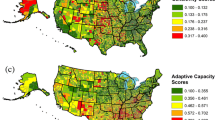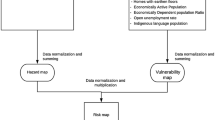Abstract
We introduce a probabilistic framework for vulnerability analysis and use it to quantify current and future vulnerability of the US water supply system. We also determine the contributions of hydro-climatic and socio-economic drivers to the changes in projected vulnerability. For all scenarios and global climate models examined, the US Southwest including California and the southern Great Plains was consistently found to be the most vulnerable. For most of the US, the largest contributions to changes in vulnerability come from changes in supply. However, for some areas of the West changes in vulnerability are caused mainly by changes in demand. These changes in supply and demand result mainly from changes in evapotranspiration rather than from changes in precipitation. Importantly, changes in vulnerability from projected changes in the standard deviations of precipitation and evapotranspiration are of about the same magnitude or larger than those from changes in the corresponding means over most of the US, except in large areas of the Great Plains, in central California and southern and central Texas.






Similar content being viewed by others
References
Barnett TP, Pierce DW (2008) When will Lake Mead go dry? Water Resour Res 44, W03201
Barnett TP, Pierce DW (2009) Sustainable water deliveries from the Colorado River in a changing climate. Proc Natl Acad Sci 106:7334–7338
Barnett T, Malone R, Pennell W, Stammer D, Semtner B, Washington W (2004) The effects of climate change on water resources in the West: introduction and overview. Clim Chang 62:1–11
Barnett TP, Adam JC, Lettenmaier DP (2005) Potential impacts of a warming climate on water availability in snow-dominated regions. Nature 438:303–309
Brown TC (2000) Projecting U.S. freshwater withdrawals. Water Resour Res 36:769–780
Brown TC, Foti R, Ramirez JA (2013) Projected freshwater withdrawals in the United States under a changing climate. Water Resour Res 49:1259–1276
Cayan DR, Das T, Pierce DW, Barnett TP, Tyree M, Gershunov A (2010) Future dryness in the southwest US and the hydrology of the early 21st century drought. Proc Natl Acad Sci 107(50):21271–21276
Christensen NS, Lettenmaier DP (2007) A multimodel ensemble approach to assessment of climate change impacts on the hydrology and water resources of the Colorado River Basin. Hydrol Earth Syst Sci 11:1417–1434
Christensen N, Wood A, Voisin N, Lettenmaier D, Palmer R (2004) The effects of climate change on the hydrology and water resources of the Colorado River Basin. Clim Chang 62:337–363
Clow DW (2009) Changes in the timing of snowmelt and streamflow in Colorado: a response to recent warming. J Clim 23:2293–2306
Dawadi S, Ahmad S (2012) Changing climatic conditions in the Colorado River Basin: implications for water resources management. J Hydrol 430–431:127–141
Dettinger M, Cayan D, Meyer M, Jeton A (2004) Simulated hydrologic responses to climate variations and change in the Merced, Carson, and American River Basins, Sierra Nevada, California, 1900–2099. Clim Chang 62:283–317
Eagleson PS (1978) Climate, soil, and vegetation. 6. Dynamics of annual water-balance. Water Resour Res 14:749–764
Famiglietti JS, Lo M, Ho SL, Bethune J, Anderson KJ, Syed TH, Swenson SC, Linage CR, Rodell M (2011) Satellites measure recent reates of groundwater depletion in California’s Central Valley. Geophys Res Lett 38:L03403
Foti R (2011) Part A: a probabilistic framework for assessing vulnerability to climate variability and change: the case of the US water supply system. Part B: dynamics of self-organized vegetation patterns. PhD thesis, Colorado State Univeristy, Fort Collins
Foti R, Ramirez JA, Brown TC (2012) Vulnerability of U.S. water supply to shortage: a technical document supporting the Forest Service 2010 RPA Assessment. Gen. Tech. Rep. U.S. Department of Agriculture, Forest Service, Rocky Mountain Research Station, Fort Collins, p 147
Hamlet AF, Mote PW, Clark MP, Lettenmaier DP (2005) Effects of temperature and precipitation variability on snowpack trends in the Western United States*. J Clim 18:4545–4561
Hurd B, Leary N, Jones R, Smith J (1999) Relative regional vulnerability of water resources to climate change. J Am Water Res Assoc 35:1399–1409
Kenny JF, Barber NL, Hutson SS, Linsey KS, Lovelace JK, Maupin MA (2009) Estimated use of water in the United States in 2005. U. S. Geological Survey, Reston, p 52
Kochendorfer JP, Ramirez JA (1996) Integrated hydrological/ecological/economic modeling for examining the vulnerability of water resources to climate change. In: North American Water and Environment Congress ‘96 – ASCE. ASCE, New York, pp. 2157–2162
Labadie JW, Larson R (2007) MODSIM 8.1: River basin management decision support system: user manual and documentation. Colorado State University, Fort Collins, p 123
Nakicenovic N, Alcamo J, Davis G, de Vries B, Fenhann J, Gaffin S, Gregory K, Grübler A, Jung TY, Kram T, Rovere ELL, Michaelis L, Mori S, Morita T, Pepper W, Pitcher H, Price L, Riahi K, Roehrl A, Rogner H-H, Sankovski A, Schlesinger M, Shukla P, Smith S, Swart R, Sv R, Victor N, Dadi Z (2000) Emissions scenarios: a special report of Working Group III of the Intergovernmental Panel on Climate Change. Cambridge University Press, Cambridge, p 599
Price DT, McKenney DW, Papadopol P, Logan T, Hutchinson MF (2006) High-resolution climate change scenarios for North America. Canadian Forestry Service, Sault Ste, Marie
Roy SB, Chen L, Girvetz E, Maurer EP, Mills WB, Grieb TM (2012) Projecting water withdrawal and supply for future decades in the U.S. under climate change scenarios. Environ Sci Technol 46:2545–2556
Scanlon BR, Faunt CC, Longuevergne L, Reedy RC, Alley WM, McGuired VL, McMahone PB (2012) Groundwater depletion and sustainability of irrigation in the US High Plains and Central Valley. PNAS 109:9320–9325
U.S. Water Resources Council (1978) The nation’s water resources 1975–2000. U. S. Government Printing Office, Washington
Vörösmarty CJ, Green P, Salisbury J, Lammers RB (2000) Global water resources: vulnerabilty from climate and population growth. Science 289:284–288
Zarnoch SJ, Cordell HK, Betz CJ, Langner L (2010) Projecting county-level populations under three climate change future scenarios: a technical document supporting the Forest Service 2010 RPA assessment. Southern Research Station, U. S. Forest Service, Ashville, p 8
Acknowledgments
This study was performed in response to the Forest and Rangeland Renewable Resources Planning Act of 1974 (public law 93–378). Funding was provided by the U.S. Forest Service with substantial contributions from Colorado State University. Partial funding was provided by the U.S. Bureau of Reclamation.
Author information
Authors and Affiliations
Corresponding author
Electronic supplementary material
Below is the link to the electronic supplementary material.
ESM 1
(PDF 3105 kb)
Appendix A - vulnerability analysis
Appendix A - vulnerability analysis
In general, vulnerability of water supply to shortage may be defined as the probability that the supply is less than the demand; that is,
where S is water supply, and D is water demand. Also, in general,
where P is precipitation, E is actual evapotranspiration, I is the net input from upstream, Q div is the net diversions (difference between diversions into and diversions out of the system), and SV is reservoir and other storage.
Defining the surplus, Z, as the difference between supply and demand, Eq. (A.1) can be rewritten as,
where μ Z = μ S − μ D , σ 2 Z = σ 2 S + σ 2 D − 2cov(S, D), β = μ Z /σ Z , and μ S , μ D, σ S , and σ D, cov(S, D), are the mean, standard deviation and covariance of water supply and water demand.
Therefore, as is clear from Eq. (A.3), the vulnerability of water supply as defined in Eq. (A.1) is a function of the mean, standard deviation and covariance of supply and water demand, that is, μ S , μ D, σ S , and σ D, cov(S, D).
We may then express the total change in vulnerability, dV, as a function of the individual contributions of changes in μ S , μ D, σ S , and σ D, cov(S, D), as follows,
where each of the partial derivatives represents the sensitivity of the vulnerability to unit changes in each of the independent variables μ S , μ D, σ S , and σ D, cov(S, D). In addition, each of the five terms of Eq. (A.4) represents the contribution to the total change in vulnerability resulting from the changes in μ S , μ D, σ S , and σ D, cov(S, D).
For the case of normally distributed surplus, Eq. (A.1) can be rewritten as,
In the case of non-Gaussian Z, Eq. (A.5) corresponds to a First Order Second Moment approximation.
Carrying out the integral of Eq. (A.5) yields,
where erf() is the Gauss error function (also known as the probability integral).
The partial derivatives appearing in Eq. (A.4) are obtained by differentiating Eq. (A.6) with respect to μ S , μ D, σ S , and σ D, cov(S, D). The resulting derivatives are shown in Eqs. (A.7–A.11).
Although not included here for brevity, the above analysis can be easily extended to define changes in vulnerability as a function of changes in the probabilistic characteristics of P, and E, explicitly.
Rights and permissions
About this article
Cite this article
Foti, R., Ramirez, J.A. & Brown, T.C. A probabilistic framework for assessing vulnerability to climate variability and change: the case of the US water supply system. Climatic Change 125, 413–427 (2014). https://doi.org/10.1007/s10584-014-1111-6
Received:
Accepted:
Published:
Issue Date:
DOI: https://doi.org/10.1007/s10584-014-1111-6




